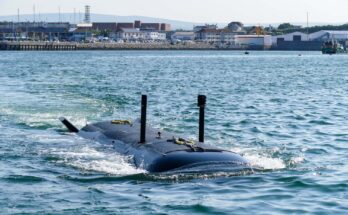
Between June 21 and 22, 2025, during a nighttime mission dubbed “Operation Midnight Hammer,” U.S. B-2 Spirit bombers from Whiteman Air Force Base in Missouri struck Iran’s underground nuclear sites at Fordow and Natanz. Six B-2’s targeted the Fordow enrichment site with twelve GBU-57 Massive Ordnance Penetrators (MOPs). Simultaneously, a seventh B-2 delivered two more MOPs against a centrifuge facility at Natanz. This marked the first known operational use of the GBU-57A/B in a combat scenario against deeply hardened nuclear targets.
What is the Massive Ordnance Penetrator?
The GBU-57A/B Massive Ordnance Penetrator is a precision-guided, earth-penetrating bomb developed specifically to neutralize deeply buried and fortified targets. Weighing approximately 30,000 pounds, this ordnance is among the heaviest in the United States Air Force inventory. In 2015, the U.S. had 20 GBU-57s. While the exact size of the current MOP stockpile is not known, fewer than six bombs are likely remaining.
Engineered for extreme penetration, it is capable of breaching 200 feet of reinforced concrete or 130 feet of rock, thanks to a specially designed high-performance steel alloy casing built to withstand high-velocity impact with hardened concrete bunkers. The warhead, a 5,300-pound BLU-127, integrates GPS and inertial navigation systems for high precision, achieving a circular error probable (CEP) of less than 16 feet. Maneuverability is also enhanced by lattice fins that adjust the bomb’s trajectory in flight.
Currently, the MOP is exclusively deployable by the B-2 Spirit stealth bomber, which can carry two GBU-57s, one in each internal bomb bay.
Development of the MOP began in 2004 after Congress defunded the Robust Nuclear Earth Penetrator. In November 2004, the Air Force Research Laboratory contracted Boeing for $30 million to develop the MOP. A prototype detonated in March 2007, at White Sands Missile Range, where its test warhead set a new record by penetrating 19 feet, 3 inches of a 20-foot, 330-ton, steel rod-reinforced concrete block.
GBU-57 MOP and Iran
The GBU-57 was designed with Iranian nuclear bunkers in mind. By 2012, concerns emerged that the original MOP lacked the capability to breach Iran’s most heavily fortified sites. As a result, the Pentagon submitted an $82 million funding request to Congress to enhance the bomb’s penetration capabilities.
In 2013, the MOP was redesigned to enable it to destroy Iran’s most heavily fortified and defended nuclear site, the Fordow complex. This latest variant has adjusted fuzes to maximize burrowing power, upgraded guidance system for greater precision, and high-tech equipment to allow it to evade Iranian air defenses. The detonator fuze was specifically adjusted to withstand impact with layers of granite and steel that encase the nuclear facility
Testing in January 2015 confirmed that this next-generation MOP could successfully defeat targets like Iran’s buried nuclear bunkers when dropped in tandem.
Operation Midnight Hammer
The June 2025 deployment of the GBU-57 against Fordow and Natanz marks the culmination of over two decades of strategic planning, technological refinement, and geopolitical signaling. From its inception in 2004, the MOP was shaped by the intelligence assessments that identified Iran’s fortified enrichment sites as a critical threat.
Over time, it became central to U.S. strategy not only as a contingency for potential military intervention, but also as a key diplomatic lever. The bomb’s existence was designed to reassure allies, particularly Israel, that the U.S. retained a credible, non-nuclear military option to halt Iran’s nuclear ambitions if diplomacy or sanctions failed. When the Israel-Iran conflict escalated in June, Israel began pressuring the U.S. to intervene with MOPs targeting critical Iranian nuclear facilities. In this context, Operation Midnight Hammer was not simply the first combat use of the MOP, it was also an attempt to fulfill the mission for which the weapon was built.
Anna Miskelley has cultivated a deep interest in global security, emerging technologies, and military systems throughout her academic and professional career. She is currently a Defense Industry Analyst with Forecast International.
Before joining Forecast International, Anna was a research fellow at the Center for Security, Innovation, and New Technology, where she researched the impact of artificial intelligence on U.S. nuclear command and control systems. Proficient in Mandarin Chinese, Anna has published research on topics including strategic stability, internal Chinese politics, and artificial intelligence.




